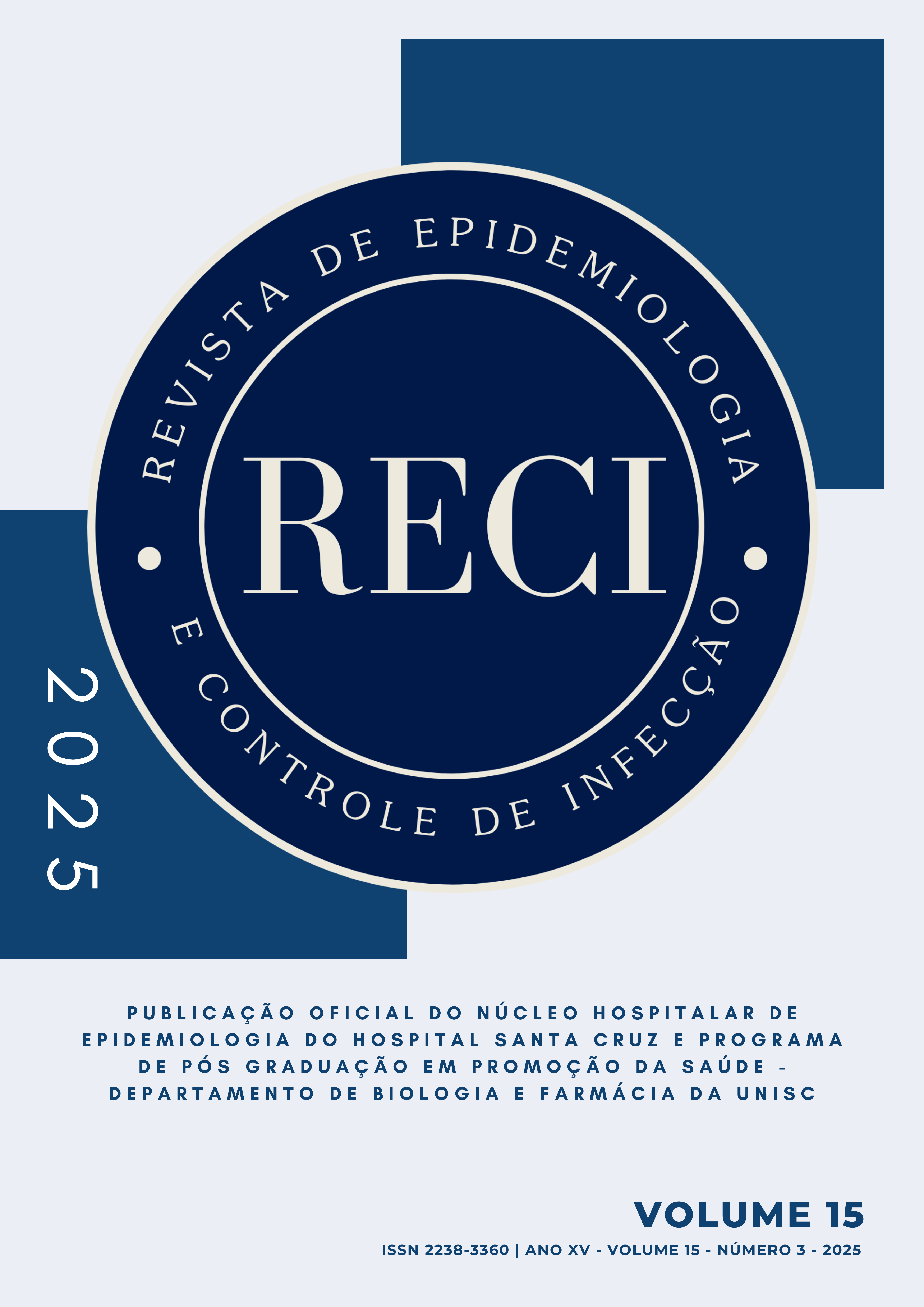Desenvolvimento e avaliação de equipamentos para desinfecção por radiação ultravioleta em ambientes de saúde
DOI:
https://doi.org/10.17058/reci.v15i3.20108Palavras-chave:
Descontaminação. Desinfecção. Raios ultravioleta. Luz UV. Radiação não ionizante.Resumo
Justificativa e Objetivos: Em hospitais, onde há alta circulação de microrganismos, tecnologias complementares são essenciais para melhorar a desinfecção. Este estudo teve como objetivo desenvolver uma tecnologia adaptada à nossa realidade, produzida e testada pelo nosso grupo de pesquisa, que seja segura e fácil de operar, com baixo custo de construção para que possa ser utilizada em ambientes de saúde com recursos limitados. Métodos: Após a investigação, lâmpadas de 55W, T8 - G13 - 909 mm com emissão de radiação ultravioleta a 254 nm foram escolhidas como fonte de UVC. O aplicativo "Torre UVC" foi criado usando o Android Studio IDE. Para verificar a eficiência do equipamento e determinar as doses a serem utilizadas, foram realizadas medições de potência através de radiômetro. Foi avaliada a eficiência da torre frente a alguns microrganismos clinicamente importantes. Resultados: A Torre UVC foi construída com uma estrutura de alumínio e 8 lâmpadas, permitindo a operação remota. O aplicativo foi projetado para uso fácil e intuitivo. Os testes de eficiência realizados com o radiômetro mostram que a diminuição da dose de radiação é exponencial à medida que objetos ou superfícies se afastam da torre. A torre inibiu o crescimento microbiano (bactérias e fungos) mesmo com baixas doses de radiação UVC (12 mJ/cm²) e reduziu a carga viral da amostra clínica positiva para SARS-CoV-2. Conclusão: Foi possível desenvolver uma tecnologia segura e de fácil operação, com baixo custo para que possa ser utilizada em ambientes de saúde, e com resultados satisfatórios na inativação de microrganismos.
Downloads
Referências
1. Jerry J, O'Regan E, O'Sullivan L, et al. Do established infection prevention and control measures prevent spread of SARS-CoV-2 to the hospital environment beyond the patient room? J Hosp Infect. 2020;105(4):589-592. doi:10.1016/j.jhin.2020.06.026.
2. Wang D, Hu B, Hu C, et al. Clinical characteristics of 138 hospitalized patients with 2019 novel coronavirus-infected pneumonia in Wuhan, China. JAMA. 2020;323(11):1061-1069. doi:10.1001/jama.2020.1585.
3. Ling Y, Xu SB, Lin YX, et al. Persistence and clearance of viral RNA in 2019 novel coronavirus disease rehabilitation patients. Chin Med J (Engl). 2020;133(9):1039-1043. doi:10.1097/CM9.0000000000000774.
4. Odoyo E, Matano D, Tiria F, et al. Environmental contamination across multiple hospital departments with multidrug-resistant bacteria pose an elevated risk of healthcare-associated infections in Kenyan hospitals. Antimicrob Resist Infect Control. 2023 Mar 29;12(1):22. doi:10.1186/s13756-023-01227-x.
5. Moccia G, Motta O, Pironti C, et al. An alternative approach for the decontamination of hospital settings. J Infect Public Health. 2020;13(12):2038-2044. doi:10.1016/j.jiph.2020.09.020.
6. Bhardwaj SK, Singh H, Deep A, et al. UVC-based photoinactivation as an efficient tool to control the transmission of coronaviruses. Sci Total Environ. 2021;792:148548. doi:10.1016/j.scitotenv.2021.148548.
7. Enaki NA, Paslari T, Bazgan S, et al. UVC radiation intensity dependence of pathogen decontamination rate: semiclassical theory and experiment. Eur Phys J Plus. 2022;127(9):1047. doi:10.1140/epjp/s13360-022-03252-y.
8. Grist SM, Geldert A, Gopal A, et al. Current understanding of ultraviolet-C decontamination of N95 filtering facepiece respirators. Appl Biosaf. 2021;26(2):90-102. doi:10.1089/apb.20.0051.
9. Riu F, Ruda A, Ibba R, et al. Antibiotics and carbohydrate-containing drugs targeting bacterial cell envelopes: an overview. Pharmaceuticals (Basel). 2022;15(8):942. doi:10.3390/ph15080942.
10. Frías-De-León MG, Hernández-Castro R, Conde-Cuevas E, et al. Candida glabrata antifungal resistance and virulence factors, a perfect pathogenic combination. Pharmaceutics. 2021 Sep 22;13(10):1529. doi:10.3390/pharmaceutics13101529.
11. Guridi A, Sevillano E, de la Fuente I, et al. Disinfectant activity of a portable ultraviolet C equipment. Int J Environ Res Public Health. 2019;16(23):4747. doi:10.3390/ijerph16234747.
12. Santos T, de Castro LF. Evaluation of a portable Ultraviolet C (UV-C) device for hospital surface decontamination. Photodiagnosis Photodyn Ther. 2020;33:102161. doi: 10.1016/j.pdpdt.2020.102161.
13. Fox-Lewis A, Fox-Lewis S, Beaumont J, et al. SARS-CoV-2 viral load dynamics and real-time RT-PCR cycle threshold interpretation in symptomatic non-hospitalised individuals in New Zealand: a multicentre cross sectional observational study. Pathology. 2021;53(4):530-535. doi:10.1016/j.pathol.2021.01.007.
14. Zou L, Ruan F, Huang M, et al. SARS-CoV-2 viral load in upper respiratory specimens of infected patients. N Engl J Med. 2020;382(12):1177-1179. doi:10.1056/NEJMc2001737.
15. Veronesi L, Colucci ME, Pasquarella C, et al. Virological surveillance of SARS-CoV-2 in an Italian northern area: comparison of real time RT-PCR cycle threshold (Ct) values in three epidemic periods. Acta Biomed. 2020;91(9-S):19-21. doi:10.23750/abm.v91i9-S.10138.
16. Aranha C, Patel V, Bhor V, et al. Cycle threshold values in RT-PCR to determine dynamics of SARS-CoV-2 viral load: an approach to reduce the isolation period for COVID-19 patients. J Med Virol. 2021;93(12):6794-6797. doi:10.1002/jmv.27206.
17. Buonanno M, Welch D, Shuryak I, et al. Far-UVC light (222 nm) efficiently and safely inactivates airborne human coronaviruses. Sci Rep. 2020;10(1):10285. doi:10.1038/s41598-020-67211-2.
18. Gidari A, Sabbatini S, Bastianelli S, et al. SARS-CoV-2 survival on surfaces and the effect of UV-C light. Viruses. 2021;13(3):408. doi:10.3390/v13030408.
19. Dexter F, Parra MC, Brown JR, et al. Perioperative Covid-19 defense: an evidence-based approach for optimization of infection control and operating room management. Anesth Analg. 2020;131(1):37-42. doi:10.1213/ANE.0000000000004829.
20. Zaman A, Majib MS, Tanjim SA, et al. UVC-PURGE: A novel cost-effective disinfection robot for combating Covid-19 pandemic. IEEE Access. 2022;S/N(1):37613-37634. doi: 10.1109/ACCESS.2022.3163243.
Downloads
Publicado
Edição
Seção
Licença
Copyright (c) 2025 Aline Teichmann, Demis Pessatto Faqui, Eduardo Dullius , Gilson Augusto Helfer, Nayanna Dias Bierhals , Maitê Souza Magdalena, Andréia Rosane de Moura Valim , Jane Dagmar Pollo Renner , Janine Koepp, Mari Ângela Gaedke, Adilson Ben da Costa

Este trabalho está licenciado sob uma licença Creative Commons Attribution 4.0 International License.
The author must state that the paper is original (has not been published previously), not infringing any copyright or other ownership right involving third parties. Once the paper is submitted, the Journal reserves the right to make normative changes, such as spelling and grammar, in order to maintain the language standard, but respecting the author’s style. The published papers become ownership of RECI, considering that all the opinions expressed by the authors are their responsibility. Because we are an open access journal, we allow free use of articles in educational and scientific applications provided the source is cited under the Creative Commons CC-BY license.


